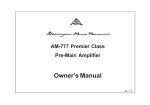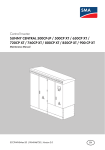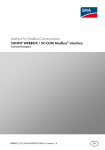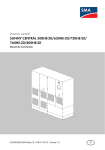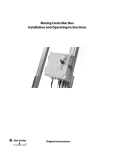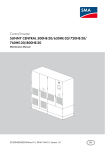Download Univex AM-77 User's Manual
Transcript
AM-77 Reference Class Dual-Mono Pre-Main Amplifier Owner’s Manual 2 FCC Declaration of Conformity - United States only This device complies with Part 15 of the FCC rules. Operation is subject to the following two conditions: (1) This device may not cause harmful interference, and (2) this device must accept any interference received, including interference that may cause undesired operation. FCC WARNING: Changes or modifications to this unit not expressly approved by the party responsible for compliance could void the user's authority to operate the equipment. NOTE: This equipment has been tested and found to comply with the limits for a Class B digital device, pursuant to Part 15 of the FCC Rules. These limits are designed to provide reasonable protection against harmful interference in a residential installation. This equipment generates, uses, and can radiate radio frequency energy and, if not installed and used in accordance with the instructions, may cause harmful interference to radio communications. However, there is no guarantee that interference will not occur in a particular installation. If this equipment does cause harmful interference to radio or television reception, which can be determined by turning the equipment off and on, the user is encouraged to try to correct the interference by one or more of the following measures: - Reorient or relocate the receiving antenna. - Increase the separation between the equipment and receiver. - Connect the equipment into an outlet on a circuit different from that to which the receiver is connected. - Consult the dealer or an experienced radio/TV technician for help. Canadian Notice (Avis Canadien) Class B Equipment This Class B digital apparatus meets all requirements of the Canadian Interference-Causing Equipment Regulations. Cet appareil numérique de la classe B respecte toutes les exigences du Règlement sur le matériel brouilleur du Canada. 3 This products complies with the EMC Directive (89/336/EEC) and the Low Voltage Directive (73/23/EEC) issued by the Commission of the European Community. Compliance with these directives implies conformity to the following European Norms (in parentheses are the equivalent international standards and regulations): o EN55022 (CISPR 22) - Electromagnetic Interference o EN55024 (IEC61000-4-2, 3, 4, 5, 6, 8, 11) - Electromagnetic Immunity o EN61000-3-2 (IEC61000-3-2) - Power Line Harmonics o EN61000-3-3 (IEC61000-3-3) - Power Line Flicker o EN60950 (IEC60950) - Product Safety 4 WARNINGS The exclamation point within an equilateral triangle is intended to alert the user to the presence of important operating and maintenance (servicing) instructions in the literature accompanying this component. ! This component weighs over 40 kilograms. Do not place this component on an unstable cart, stand, tripod, bracket or table as the component may fall causing serious injury to a child or adult and serious damage to the unit. An appliance and cart combination should be moved with care. Quick stops, excessive force and uneven surfaces may cause the component and cart combination to overturn. Any mounting of the device on a wall or ceiling should follow the manufacturer’s instructions and should use a mounting accessory recommended by the manufacturer. Read and follow all the safety and operating instructions before connecting or using this component. All warnings on the component and in its operating instructions should be adhered to. Retain this Owner’s Manual for future reference. Do not use this unit near water; for example, near a bath tub, washbowl, kitchen sink, laundry tub, in a wet basement or near a swimming pool. Unplug the component from the wall outlet before cleaning. Never use benzine, thinner or other solvents for cleaning; use only a soft damp cloth. 5 Care should be taken so that objects do not fall, and liquids are not spilled into the enclosure through any openings. This component should be serviced only by qualified AMR service personnel when: A. The power cable or the power input socket has been damaged; B. Objects have fallen, or liquid has been spilled into the component; C. The component has been exposed to rain or liquids of any kind; D. The component does not appear to operate normally or exhibits a marked change in performance; E. The component has been dropped or the enclosure has been damaged. DO NOT ATTEMPT SERVICING OF THIS UNIT-YOURSELF. REFER SERVICING TO QUALIFIED AMR SERVICE PERSONNEL Upon completion of any servicing or repairs, request the service point’s assurance that only AMR Authorised Replacement Parts with the same characteristics as the original parts have been used, and that the routine safety checks have been performed to guarantee that the component is in a safe operating condition. REPLACEMENT WITH UNAUTHORIZED PARTS MAY RESULT IN FIRE, ELECTRIC SHOCK OR OTHER HAZARDS 6 Precautions This equipment has been tested and found to comply with the limits set out in the EMC Directive using a connection cable shorter than 3 metres. On power sources The mains power cable should be routed so that it is not likely to be walked on or pinched, especially near the plug or back panel receptacle. The component should not be disconnected from the AC power source as long as it is connected to the wall outlet, even if the component itself has been turned off. If this component is not going to be used for a long time, be sure to disconnect the component from the wall outlet. To disconnect the AC power cable, grasp the plug itself; never pull the cable. CAUTION RISK OF ELECTRIC SHOCK DO NOT OPEN ! On placement With a total of 2 thermionic electron valves, the AM-77 may become warm during operation. This is normal. Given this, it is imperative that the AM-77 when installed, its location or position DOES NOT interfere with its proper ventilation. For example, it should not be situated on a bed, sofa, rug or similar surface that may block the top or bottom ventilation openings; or placed in a built-in installation, such as a bookcase or cabinet, that may impede the flow of air through its top and bottom ventilation openings. Do not place the component in a location near heat sources, or in a place subject to direct sunlight, excessive dust, or mechanical shock. Do not place the component in an inclined position. It is designed to be operated in a 7 horizontal position only. Do not place heavy objects on the component. Keep the component away from equipment with strong magnets, such as microwave ovens or large loudspeakers. To prevent fire or shock hazard, do not place vessels filled with liquids, such as vases, on the component. Touch-Sensitive Buttons On the front fascia of this AMR component are touch-sensitive buttons. Due to the wide variance of climes around the world, instances may arise where to activate a button: - the touching finger may be required to be in contact with both the button and the front fascia to register; - the touching finger may have to touch the chassis to discharge any static electricity prior to button selection. Running-In AMR estimates that the AM-77 may take between 300-500 operating hours for all of the internal components to be fully-broken in. Please anticipate the sonic performance of the AM-77 to settle only after it has been used for this approximate length of time. Stand-By Please note that the solid state section needs to find its equilibrium and due to the (unavoidable) use of electrolytic capacitors (and an effect called soakage) around 24-48 hours of ‘standby’ (or operation) are required to stabilise performance. Therefore, ‘standby’ does not shut down the solid-state sections, only the valves. 8 Contents WARNINGS 5 Section 1 - Unpacking and Setup 11 12 1a. Unpacking 1b. Setup Section 2 - Component Overview 15 2a. Start-Up Section 3 - Advanced Features 3a. 3b. 3c. 3d. Labeling of Inputs and Setting Level Offset Setting Fixed Input Level OptiMains® Protection for Excessive Under/Over-Voltages OptiProtect® Speaker Overload Protection 25 25 28 30 31 9 Section 4 - System Configurations 4a. OptiOperation® Different System Configurations 4b. Switching and Connection Diagrams for Different Modes Section 5 - Additional Connectivity 33 33 41 5a. Input for iPod/other portable music players 5b. ‘HiFi/Pro’ Switches for Balanced XLR inputs 5c. RS232 ‘Options’ Connector 53 53 54 55 Section 6 - Technical Features 57 Appendix - Troubleshooting & Maintanence Troubleshooting Maintenance 58 58 58 Specifications 59 10 Section 1 - Unpacking and Setup Figure 1.1 - Front Panel of the AM-77 DUAL - MONO AMPLIFIER AM - 77 Figure 1.2 - Rear Panel of the AM-77 Speaker Output Balanced Input _ + Speaker Output Power On HiFi Off Pro Dual - Mono Amplifier AM - 77 In _ + Out Designed and Engineered in Great Britain R 1 Mode 2 3 4 5 Sync L L M L R M M IR Link R Power Amp Int Amp Under normal operation , set all switches to the default ( bold ) position . Please refer to the instruction manual for further details . Option Inputs CAUTION ATTENTION RISK OF ELECTRIC SHOCK DO NOT OPEN RISQUE DE CHOC ELECTRIQUE NE PAS OUVRIR ! No User Serviceable Components Inside. For service , contact your Authorised Dealer or Distributor . Any modifications to this equipment will void all warranties . ~ AC IN 90V 135V 190V 260V SERIAL NO. 11 Thank you for purchasing this AMR reference class component. We hope you derive as much pleasure from using this component as we have enjoyed making it for you. 1a. Unpacking This section refers to the unpacking of the AM-77 and its subsequent setup. Upon unpacking, please find: Please that check all contents are present i. ii. iii. iv. v. vi. vii. viii. ix. x. AM-77 Reference Class Dual-Mono Pre-Main Amplifier. RC-77 Remote Commander (with 2 x AAA batteries). PC-77 OptiLink® Reference mains power cable. IC-77 OptiLink® Reference interconnect cable (XLR-type). Synchronisation (3.5mm jack) cable (for linking-up multiple AM-77s). AM-77 Owner’s Manual. Quick-Start Card. AMR Warranty Card. AMR Test Disk. Aluminium professional flightcase. Please ensure that all items are present. Should an item be missing, please contact your AMR distributor/dealer. 12 1b. Setup Pre-Main Stereo Amplifier Connection Default pre-main mode: the AM-77 as an integrated amplifier The following diagrams illustrate the standard connection of the AM-77 in pre-main stereo amplifier mode. This is the default factory setting and is suitable for the majority of audio systems. Figure 1.3 depicts the use of standard banana/spade speaker connectors while figure 1.4 illustrates the use of Speakon connectors. Speaker R Speaker L 100 100 Sensitivity: Impedance: Cont . Power Handing : Peak Prog . Handing: Frequency Response: 90 HF Level Adjustment Resistor 80 70 60 50 100 1000 87dB 8Ohms 150W 600W ( see graph ) 90 Output ( dB ) 87dB 8Ohms 150W 600W ( see graph ) Output ( dB ) Sensitivity: Impedance: Cont . Power Handing : Peak Prog . Handing: Frequency Response: HF Level Adjustment Resistor 80 70 60 50 10000 100 Frequency ( Hz ) LS - 77 Professional Monitor Designed and Engineered in Great Britain HF HF LF Pro HiFi Warning: ensure no speaker connector is in contact with the chassis to cause a short-circuit! 1000 10000 Frequency ( Hz ) LS - 77 Professional Monitor Designed and Engineered in Great Britain LF IN OUT IN OUT Speaker Cable Speaker Cable Speaker Output Mode Balanced Input _ + Speaker Output Power On Pro HiFi In Dual - Mono Amplifier AM - 77 Off _ + Out Designed and Engineered in Great Britain R L R 3 2 5 4 Sync L L M M 1 Mode L R M M IR Link R M M Option Power Amp Int Amp ~ AC IN 90V 135V 190V 260V Inputs Under normal operation , set all switches to the default ( bold ) position . Please refer to the instruction manual for further details . CAUTION ATTENTION RISK OF ELECTRIC SHOCK DO NOT OPEN RISQUE DE CHOC ELECTRIQUE NE PAS OUVRIR ! No User Serviceable Components Inside. For service , contact your Authorised Dealer or Distributor . Any modifications to this equipment will void all warranties . SERIAL NO. AM - 77 Interconnect Cable Power Amp Int Amp Interconnect Cable Analog Outputs Analog Outputs Power On Off Compact Disk Processor CD - 77 Designed and Engineered in Great Britain USB Input IR Link ! R CAUTION ATTENTION RISK OF ELECTRIC SHOCK DO NOT OPEN RISQUE DE CHOC ELECTRIQUE NE PAS OUVRIR CLASS 1 LASER PRODUCT No User Serviceable Components Inside. For service, contact your Authorised Dealer or Distributor. Any modifications to this equipment will void all warranties. ~ AC IN 90V 135V 190V 260V L SERIAL NO. CD - 77 13 Figure 1.3 - System connection using banana plug/spade connector equipped speaker cables Speaker R 100 87dB 8Ohms 150W 600W ( see graph ) 100 Sensitivity: Impedance: Cont . Power Handing : Peak Prog . Handing: Frequency Response: 90 HF Level Adjustment Resistor 80 70 60 50 100 1000 87dB 8Ohms 150W 600W ( see graph ) 90 Output ( dB ) Sensitivity: Impedance: Cont . Power Handing : Peak Prog . Handing: Frequency Response: Output ( dB ) AMR recommends the sonically superior Speakon connectors Speaker L HF Level Adjustment Resistor 80 70 60 50 10000 100 Frequency ( Hz ) LS - 77 Professional Monitor Designed and Engineered in Great Britain HF HF LF Pro HiFi 1000 10000 Frequency ( Hz ) LS - 77 Professional Monitor Designed and Engineered in Great Britain LF IN OUT IN OUT Speaker Cable Speaker Cable Speaker Output Mode Balanced Input _ + Speaker Output Power On Pro HiFi In Dual - Mono Amplifier AM - 77 Off _ + Out Designed and Engineered in Great Britain R L R 3 2 5 4 Sync L L M M 1 Mode L R M M IR Link R M M Option Power Amp Int Amp ~ AC IN 90V 135V 190V 260V Inputs Under normal operation , set all switches to the default ( bold ) position . Please refer to the instruction manual for further details . CAUTION ATTENTION RISK OF ELECTRIC SHOCK DO NOT OPEN RISQUE DE CHOC ELECTRIQUE NE PAS OUVRIR ! No User Serviceable Components Inside. For service , contact your Authorised Dealer or Distributor . Any modifications to this equipment will void all warranties . SERIAL NO. AM - 77 Interconnect Cable Power Amp Int Amp Interconnect Cable Analog Outputs Analog Outputs Power On Off Compact Disk Processor CD - 77 Designed and Engineered in Great Britain USB Input IR Link ! R CAUTION ATTENTION RISK OF ELECTRIC SHOCK DO NOT OPEN RISQUE DE CHOC ELECTRIQUE NE PAS OUVRIR CLASS 1 LASER PRODUCT No User Serviceable Components Inside. For service, contact your Authorised Dealer or Distributor. Any modifications to this equipment will void all warranties. ~ AC IN 90V 135V 190V 260V L SERIAL NO. CD - 77 Figure 1.4 - System connection using Speakon connector equipped speaker cables i. ii. iii. 14 Connect the respective spade/banana/Speakon connectors of the speaker cables to the AM-77. Connect the source/s via the respective left and right XLR or RCA connectors to Inputs 1-5. Connect the IEC of the PC-77 mains power cable to the AM-77 and the socket to a mains source. Section 2 - Component Overview Figure 2.1 - AM-77 Front Fascia The plastic protective film covering the display may be removed DUAL - MONO AMPLIFIER AM - 77 F1 F1. F2. F3. F4. F5. F2 F3 F4 F5 STANDBY switch: to place the AM-77 in active or standby mode. SOURCE selection buttons: to select between the 5 different inputs. VOLUME buttons: to adjust the volume level. iPod 3.5 Input Connector: for the connection of an iPod or similar portable music device. iPod USB charging connector: for re-charging an iPod or similar portable music device. 15 Figure 2.2 - AM-77 Rear Panel Warning: ensure no speaker connector is in contact with the chassis Speaker Output Balanced Input _ + Speaker Output Power On HiFi _ Off Pro Dual - Mono Amplifier AM - 77 In + Out Designed and Engineered in Great Britain R 1 Mode 2 3 4 5 Sync L L M L R M M IR Link R Power Amp Int Amp Under normal operation , set all switches to the default ( bold ) position . Please refer to the instruction manual for further details . R1 R3 R2 R1. R2. R3. R4. R5. R6. 16 CAUTION ATTENTION RISK OF ELECTRIC SHOCK DO NOT OPEN RISQUE DE CHOC ELECTRIQUE NE PAS OUVRIR R5 R4 Option Inputs ! Dealer or Distributor . Any modifications to this equipment will void all warranties . R7 R6 ~ AC IN 90V 135V 190V 260V No User Serviceable Components Inside. For service , contact your Authorised SERIAL NO. R9 R8 R11 R10 R12 SPADE/BANANA outputs: for connection of standard termination speaker cables. SPEAKON outputs: for connection of Speakon terminated speaker cables. HIFI/PRO switch: to allow for a source with transformer balanced output*. INT/POWER Amp switch: to alternate between Pre-Main and Power Amplification setings*. MODE switch: to alternate between Stereo/Monoblock/Bi-Amplification settings*. INPUT 1: shared XLR and RCA input, for signal input of source equipment. R7. INPUTS 2-5: RCA inputs, for signal input of source equipment. R8. SYNC connectors: for connection of more than one AM-77*. R9. RS232 option connector: to facilitate future upgrades*. R10. Infra-Red Link: for connection of a wireline remote control. R11. IEC power connector: for the connection of a PC-77 mains power cable to the AM-77. R12. POWER Switch: to switch on mains electricity to the AM-77. In the majority of audio systems, the AM-77 is most likely to be operated as a Pre-Main Amplifier: please inspect the rear panel of the AM-77 to verify that the default settings (in bold) to enable the AM-77 to operate in this mode are as follows: 1. HIFI/PRO switches are set to ‘HiFi’ (left position) 2. MODE switch is set to ‘LR’ (middle position) 3. INT/POWER switch is set to ‘Int’ (right position) * Please refer to Sections 3 - 5 for a more detail explanation. 17 Figure 2.3 - RC-77 Remote Control CD P ro c e RC1 Amp li fi e ssor RC7 r RC2 RC6 RC5 kHz RC3 RC1. MENU button: to enter Advanced Features mode*. RC2. STANDBY button: to place the AM-77 in active or standby mode. RC3. SOURCE selection buttons: to select between the 5 different inputs. RC4. VOLUME buttons: to adjust the volume level. RC5. MUTE button: to Mute (temporarily turn off sound) the AM-77. RC6. BRIGHTNESS button: to adjust brightness levels*. RC7. OK button: to be used in Advanced Features mode*. * Please refer to Section 3 - Advanced Features section for more details IN VOL R EM O TE CO MM AN RC D ER 77 RC4 RC-77: battery installation To install the 2 x AAA batteries, using a Philips screwdriver, remove the four screws at the four corners of the rear battery compartment. Install the 2 x AAA batteries in the correct direction according to the baseplate inside the battery compartment. Replace the battery compartment and the four cover screws. 18 2a. Start-Up 1. Power On/Off Press the ‘POWER’ rocker switch (R12) at the rear of the AMP to switch on mains power to the AM-77. Once powered OFF: always wait 30 seconds before switching on again To switch the mains power OFF, press again and release. Always WAIT at least 30 seconds before switching ON again. This is to enable the OptiMains® circuit to shutdown properly. The display will light up to indicate the unit is switched on and ready for use. This should take just under 1 minute as the OptiMains® circuit is verifying and the AM-77 is warming up. The display should flash the message: O p t i m i s i n g V o l t a g r m i n g S u p p l y e The display will look like this: W a U p 45 s The display will then show the remaining warm-up time. 19 Once the system check is complete and the OptiMains®circuitry has completed its initiation process, the AM77 is ready for operation. 2. Standby After start-up, pressing the STANDBY button (F1) on either the front fascia or the RC-77 (RC2), the AM-77 will switch to STANDBY mode. S t a n d b y 3. Source Selection From either the front fascia of the AM-77 (F2) or the RC-77 (RC3), select the desired source input for playback. C D P l a y e r - 3 6 d With PLAY selected from a connected source such as a CD-77, playback is attained. 20 B 4. Volume Adjustment Beware: prolonged listening at high volume levels is likely to damage your hearing From either the front fascia of the AM-77 (F3) or the RC-77 (RC4), select the desired volume. While adjusting volume levels, there is an audible “click” from AM-77 and the speakers. This is the normal operation of the relays within the OptiLevel® direct path precision volume control. 5. Rear Inputs At the rear of the AM-77, there are 5 inputs for the connection of source components such as the CD-77 compact disk processor or a vinyl source. Input 1 (R6) is of most consequence because first, while all 5 inputs can be connected via RCA only, Input 1 also allows for the optional connection of XLR connectors. Second, in other configurations where the AM-77 is used in single-channel mode, all other inputs are defeated. Signal input is allowed only through the LEFT channel (white) of Input 1: via XLR or RCA (Please refer to Section 4 - System Configurations for a detailed explanation). 6. Speakon Outputs At the rear of the AM-77 are Speakon female connectors (R2) to allow speaker cables terminated with Speakon male connectors to be connected to the AM-77. 21 7. Synch Connectors At the rear of the AM-77 are Synchronisation ‘In’ and ‘Out’ connection points (R8). This is for the linking of multiple AM-77s for alternative system configurations. Please refer to Section 4 - System Configurations for a detailed explanation. 8. Mode switch At the rear of the AM-77 the ‘Mode’ switch (R5) allows for the AM-77 to alternate between Stereo/Monoblock/Bi-Amplifier modes. Please refer to Section 4 - System Configurations for a detailed explanation. 9. Int/Power switch At the rear of the AM-77, the ‘Int/Power’ switch (R4) enables the AM-77 to alternate between pre-main or power amplification modes. Please refer to Section 4 - System Configurations for a detailed explanation. 10. HiFi/Pro switch At the rear of the AM-77, the ‘HiFi/Pro’ switch (R3) allows for a source with a transformer balanced output to be connected to the AM-77. Please refer to Section 5 - Additional Connectivity for a detailed explanation. 11. RS232 option connector At the rear of the AM-77, the RS232 connector (R9) allows the AM-77 to be upgraded. Please refer to Section 5 - Additional Connectivity for a detailed explanation. 22 12. Menu (RC-77 only) The MENU button (RC1) will enter the Advanced Menu system of the AM-77. Please refer to Section 3 Advanced Features for a detailed explanation. 13. OK (RC-77 only) The OK button on (RC7) the RC-77 is for the confirmation of a desired selection within the Advanced Menu system of the AM-77. Please refer to Section 3 - Advanced Features for a detailed explanation. 14. Mute (RC-77 only) The MUTE button (RC5) will disengage the volume of the AM-77 and re-engage the volume if it is pressed again. 15. Brightness (RC-77 only) The BRIGHTNESS button (RC6) will adjust the display’s brightness at the front fascia of the AM-77. There are 4 different brightness settings including display off. With its own isolated power supply, with the display ON or OFF, there is no sonic impact upon the AM-77. 23 24 Section 3 - Advanced Features The following section provides instructions to access the AM-77’s advanced features. 3a. Labeling of Inputs and Setting Level Offset With the AM-77, in one process, it is possible to label each of the 5 inputs with a corresponding source and to set the respective level offset. This function is recommended only after ALL desired sources have been connected to the AM-77. A list of available labels is shown overleaf in chronological order. The main advantage of setting the level offset is that the volume level will change in real-time, so that the user may adjust the offset without the need for additional equipment. By using this function and selecting the desired level offset, one may ‘match’ the volume level of all inputs so that when switching between sources, the volume remains the same, thereby avoiding undesirable and potentially equipment-damaging noise levels. For example: Input 1 CD Player (2V output) Offset: 0dB Input 2 LP (1V output) Offset: +6dB Input 3 SACD Player (4V output) Offset: -6dB 25 List of available inputs: All types of sources accomodated 1. Input X (default) 15. MP3 Player 2. Aux I 16. PC Audio 3. Aux II 17. Phono Stage 4. Aux III 18. Plasma TV 5. CD Processor 19. Pre-Amplifier 6. D/A Processor 20. SACD Player 7. DVD Player 21. Tape Deck 8. DVD Recorder 22. Television 9. HD Recorder 23. Tuner 10.HDTV 24. Turntable 11.Home Theatre 25. Uni Player 12.iPod 26. Video Player 13.LCD TV 27. Home Theatre Direct 14.Media Center 26 The following steps outline the procedure to label all the inputs and set the respective level offset. The AM-77’s default labelling of its inputs starts from ‘Input 1’ and runs through to ‘Input 5’: i. Press ‘MENU’ (RC1) on the RC-77. ii. The display will flash ‘Labelling Input 1’. iii. The 2nd line of the display will commence with the first from a list of input labels (please see the previous page for a list of input labels). iv. Scroll using the ‘+/- buttons’ of the Volume (RC4). iv. At the desired label, press ‘OK’ (RC7) to store the new label for that specific input. v. The display will flash ‘Level Offset’. On the RC-77, using ‘+/-’ volume buttons, select the desired level, press ‘OK’ (RC7) to confirm. vi. The display will move onto ‘Labelling Input 2’. vi. Repeat this process for the other inputs. vii. One the last input, Input 5 has been programmed, press ‘OK’. viii. Normal operation will resume at Input 5. If this is not the desired input, use SOURCE (F2) or (RC3) to select the input of choice to resume listening. 27 3b. Setting Fixed Input Level When using the AM-77 as part of a home theatre system with an external processor controlling the overall system volume, it is possible to program one of the five input sources to have a fixed level of Input such as for a home theatre system of either 0.775V (0dbu) or 1.55V (+6dBu). This allows the 2-Channel music system to be seamlessly integrated into a high performance multi-channel home cinema system. - Go to Section 3a and follow the instructions to select the last label: H o m e D i T h e a r e c t t r e - Simultaneously press ‘-’ volume on the front fascia of the AM-77 and ‘OK’ on the RC-77. 28 - Having entered the ‘Fixed Input’ menu, now select: HTD mode: always use an external pre-amp as this mode will switch the AM77 to full volume! Fixed Input 1.55V = +6dBu or Fixed Input 0.775V = 0dBu Warning! By selecting Home Theater Direct mode, the volume of the amplifier will be switched to full. Hence if it is used incorrectly, it will damage the connecting speakers. AMR assumes no responsibility for any speaker damage arising from the use of the AM-77. 29 3c. OptiMains® Protection for Excessive Under/Over-Voltages The AM-77 is fitted with the OptiMains® system to condition and adjust the incoming mains supply for best operation under all normal mains conditions (including situations that will cause audible problems without OptiMains®). Sometimes there are excessive mains fluctuations In almost every country throughout the world, instances do arise where fluctuations in the main electricity exceeds that of a correctly operating mains supply and any electrical item/product is no longer properly served. In the case of extreme power surges, brown outs or other exceptional/unexpected conditions that exceed the safety margins, the OptiMains® system automatically will switch off the mains power to the internal parts of equipment to prevent any damage from occuring. If the display reads: ...OptiMains® will detect and protect A C O p V o l t a g e O u t s i d e r a t i n g R a n g e ! e Power OFF your AMR component and wait at least 5 minutes. If and when the mains electricity has been deemed to have returned to normal (such as during a brown out and the lights have dimmed but have returned to normal brightness) then power up your AMR component as per the manual’s instructions. 30 3d. OptiProtect® Speaker Overload Protection Within OptiProtect® the AM-77 has an in-built speaker protection circuit. Unlike common protection systems which are in series with the speaker output and where the music signal always passes through the protection circuit, the AMR speaker protection system acts as a crowbar circuit shorting across the output - hence it is separate from the audio circuitry and does not affect the sound quality unless it is engaged. This is mainly a final safeguard against equipment failure and/or extreme levels of over-driving the amplifier and speakers. When the display shows: If there are any questions, please contact your nearest AMR distributor/dealer S p e a k e r E n g P r o t e a g e d ! c t i o n This indicates that the AM-77 has detected an output condition that could potentially damage the speakers connected to it. Normally switching the AM-77 off, waiting 20 seconds and switching it back on will reset the protection circuit if the cause was for example, excessive signal levels. In the extremely rare event that an internal malfunction of the AM-77 is the cause for the protection circuit to engage, the protection will re-engage on switch-on, indicating the need for the AM-77 to be serviced. 31 32 Section 4 - System Configurations 4a. OptiOperation® Different System Configurations It is assumed all prior sections have been read & understood with all requisite connections made Six different modes Supreme adaptability In keeping with AMR’s philosophy that ‘no one sound fits all’ the AM-77 is also adaptable to suit virtually any system configuration: able to operate at one end, as a pre-main stereo amplifier and at the other, as a singlechannel power amplifier. In pre-main amplifier mode, the AM-77 will use both the pre- and power amplification sections: the AM-77 controls volume level and input selection controls. In power amplification mode, the AM-77 wil require an external, separate pre-amplifier to handle volume and input selection duties. The following section describes alternative configurations for the AM-77 beyond the factory default: pre-main stereo amplifier setting. With diverse system permutations in mind, the AM-77 has built-in, six OptiOperation® modes to seamlessly integrate it into virtually any audio system configuration: Mode Mode Mode Mode Mode Mode I. II. III. IV. V. VI. Pre-Main Stereo amplifier mode (default) Pre-Main Monoblock amplifier mode Pre-Main Bi-amplifier mode (horizontal biamping) Power amplifier Stereo mode Power amplifier Monoblock mode Power Bi-amplifier mode (horizontal biamping) The combination of synchronising multiple AM-77s together in practical terms is limited only by room size and cost. This approach allows for systems at the core, comprising of any number of AM-77s to be constructed to any level of complexity. 33 In short, the AM-77’s flexibility is limited only to that of the imagination. For example, one may employ: - 3xAM-77s synchronised along with a high-quality digital crossover to drive a fully-active 3-way speaker system to the highest possible level of sound reproduction or; - 3xAM-77s synchronised for a multi-channel surround sound system or; - 2xAM-77s synchronised in monoblock or bi-amplification mode to drive suitably-equipped speakers. Figure 4.0 - Connection of more than one AM-77 Before an alternative configuration is selected, ALWAYS ensure the AM-77 is switched OFF Speaker Output Balanced Input _ + Speaker Output Power On Pro HiFi In Dual - Mono Amplifier AM - 77 Off _ Speaker Output + Balanced Input _ + R 1 Mode 2 3 Sync L L M L R M M R 1 Mode 2 3 5 4 CAUTION ATTENTION RISK OF ELECTRIC SHOCK DO NOT OPEN RISQUE DE CHOC ELECTRIQUE NE PAS OUVRIR ! L R M M IR Link Option No User Serviceable Components Inside. For service , contact your Authorised Dealer or Distributor . Any modifications to this equipment will void all warranties . Power Amp Int Amp Under normal operation , set all switches t
































































